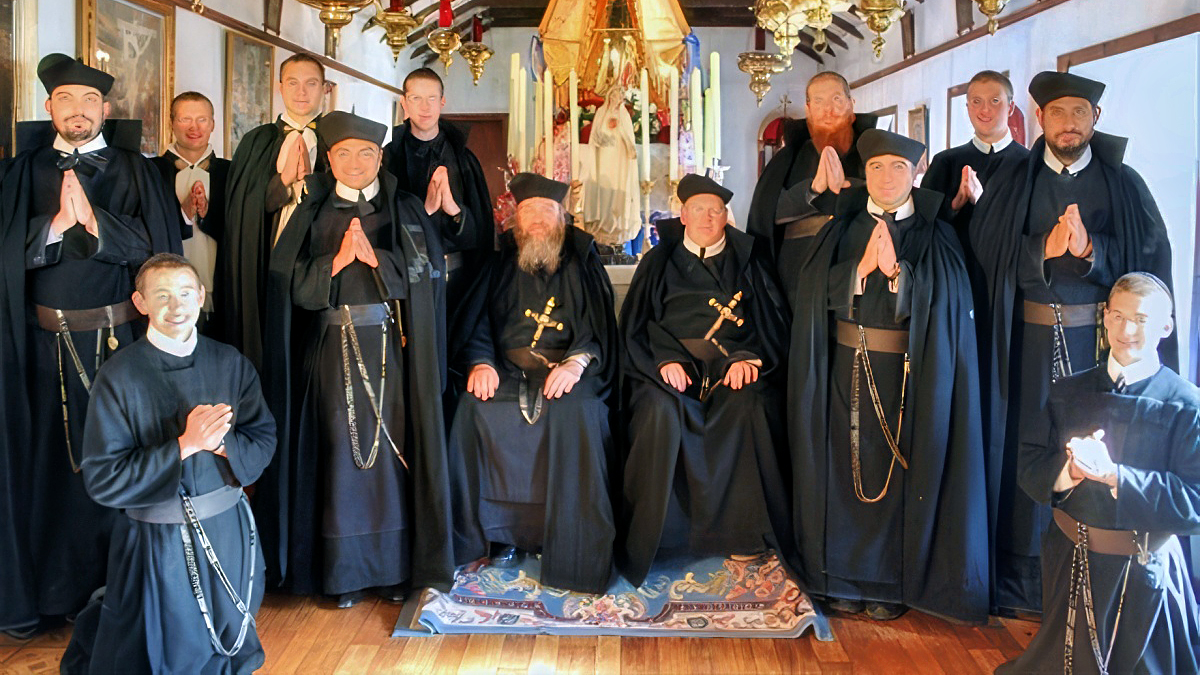Almost 20 years ago, Pope Benedict XVI extended an outstretched hand to friends of the pre-conciliar liturgy.
With his motu proprio Summorum Pontificum in 2007, he made it considerably easier to celebrate according to the 1962 missals.
One community that accepted this outstretched hand was the Transalpine Redemptorists.
This was by no means a foregone conclusion from the history of the order.
It was founded in 1988 by the former Redemptorist Michael Mary Sim; outside the church.
Origins linked to the Society of St Pius X
At that time, Brother Michael Mary was no longer in communion with the Church, but had long been associated with the traditionalist Fraternity of St Pius X.
The community of priests founded by Archbishop Marcel Lefebvre had long since lost its ecclesiastical recognition.
In the same year, Lefebvre consecrated four bishops for his community — a schismatic act, as Pope John Paul II recognised.
Founded under the rule of St Alphonsus
It was in this environment that the order, which lives according to the rule of St Alphonsus of Liguori, founder of the Redemptorists, was founded.
But it was founded outside the church.
For this reason, the members were not allowed to administer the sacraments from the outset; they were not allowed to exercise their ordained ministry.
A schism did not even have to be formally recognised.
A turning point under Benedict XVI
The turning point came with Benedict XVI.
In the early years, the community changed its location several times.
Their first monastery was on the island of Sheppey in southern England near Kent.
Six years after their foundation, they moved to a French monastery.
Their current headquarters, the island of Papa Stronsay in Scotland, has existed since 1999, when the monks bought the entire island in the Orkney archipelago and founded their monastery Golgotha there.
The island is said to have cost 250 000 British pounds — just under 600 000 euros today, taking inflation into account.
Publications and lay outreach before recognition
The Transalpine Redemptorists lived there for several years, published a traditionalist magazine, and ran a lay community, the Purgatory Archconfraternity.
All this occurred without integration into the Catholic hierarchy — outside the Church and without authorisation according to canon law.
“Summorum Pontificum” and a path back to communion
The turning point then came with Summorum Pontificum.
Benedict XVI’s understanding of the Roman Rite as a liturgical family consisting of an ordinary form — reformed after the Second Vatican Council — and an extraordinary form — according to the 1962 books — paved the way back into communion with the Church for the Transalpine Redemptorists.
They asked the Roman authority responsible for traditionalists, the Ecclesia Dei Commission, to lift the canonical sanctions.
With success: on 1 July 2008, Brother Michael Mary announced his incorporation into the Church.
“All canonical penalties have been lifted,” he wrote. “Our community is now very happy that we have unquestionable and harmonious communion with the Holy See because our priests are now canonically regular.”
Limits on ministry and the road to recognition
However, this was only the first step.
The priests were rehabilitated and were now allowed to function officially as priests.
Strictly speaking, however, the community was not yet a religious order; it first needed recognition by the church hierarchy.
As this was still lacking, restrictions initially applied.
The priests were only allowed to work on their island, not beyond.
Towards diocesan establishment in Aberdeen
Finally an accepted order.
Brother Michael Mary also announced that his community was endeavouring to be canonically established as a religious order.
The island of Papa Stronsay lies within the Diocese of Aberdeen.
The bishop of this diocese, then as now Hugh Gilbert, a Benedictine, was responsible for the recognition.
A few changes were made on the way to recognition.
The habit of the religious was altered slightly to distinguish them from the regular Redemptorists.
The name was changed to “Sons of the Most Holy Saviour,” and the term “Transalpine Redemptorists” has only been used informally since then.
Formal establishment and expansion to New Zealand
The breakthrough came in 2012.
The community, then consisting of 15 men, was formally established as an order under diocesan law by Bishop Gilbert.
In 2017, the order expanded to New Zealand, where they settled in the Diocese of Christchurch.
Allegations of unauthorised exorcisms
Up to this point, the story could have been considered a success of Pope Benedict XVI’s project of liturgical peace to strengthen unity.
But things turned out differently.
In 2017, New Zealand media reported on unauthorised exorcisms.
People, including children, were allegedly traumatised in the process.
The news programme Newshub reported on at least seven people who had undergone exorcisms, citing former members, worshippers, and psychological support facilities.
The diocese told Newshub that the predecessor of current Bishop Michael Gielen, Bishop Paul Martin, had authorised an exorcism in only two cases.
The religious refuted the allegations, stating there had been no exorcisms without episcopal permission and none on minors.
Vatican visitation and diocesan expulsion
Visitation due to exorcisms in New Zealand.
Following the media reports, the Vatican dicastery for religious orders ordered a visitation of the community.
The details of what the apostolic visitators, led by Australian Bishop Robert McGuckin in Christchurch, found are not known; as is usual, the results remain sealed.
However, the findings were apparently clear enough for Bishop Gielen to take firm action.
In July 2024, he expelled the community from his diocese.
Individual priests of the order have not been allowed to exercise priestly ministries there since.
As diocesan bishop, he can decide which religious orders operate in his area.
In his letter on the expulsion, Gielen referred to recommendations from the dicastery for religious orders following the visitation.
Appeal rejected and ongoing tensions
The order’s appeal against the bishop was unsuccessful.
A complaint submitted directly to the Vatican was rejected in summer 2025.
Gielen informed his diocese of this in a letter.
Meanwhile, the situation worsened.
The Transalpine Redemptorists were still active in the diocese and, according to the bishop, had even brought more members to New Zealand.
Gielen spoke of “challenges for unity and obedience within the Church.”
The decision from Rome made it clear that the expulsion from Christchurch was lawful and that the sacraments administered by members of the order there were unauthorised.
General chapter and an open letter
This defeat was a turning point for the religious.
The time of demonstrative and unrestricted unity with the church was over.
In mid-October this year, the general chapter met at the main house on Papa Stronsay and formulated an open letter “to the Catholic bishops, priests, religious and faithful.”
In fact, the letter probably constituted a schismatic act.
Canon law speaks of schism when “submission to the Pope or communion with the members of the Church subject to him” is refused.
Although the letter affirms “deep communion with our holy mother, the Church,” it also rejects the ecclesiastical hierarchy — in particular the Bishop of Christchurch.
The “chain of command” had been broken.
Points rejected and wider grievances
An open letter as a schismatic act?
In their letter, the religious explicitly reject 16 points, including documents from Pope Francis’ pontificate.
They name the post-synodal letter Amoris Laetitia with its liberalisation of communion, the restrictions on the pre-conciliar liturgy through Traditionis custodes, and the permission for blessings of same-sex couples Fiducia supplicans.
Apparently, the Transalpine Redemptorists have a lot pent up.
They reject the New Zealand bishops’ corona measures, ecumenical signs from Bishop Gielen, and the “synodal church” as a whole.
Possible schism and next steps for authorities
There is now no trace of the undoubted and harmonious communion with the Holy See that Brother Michael Mary wrote about in 2008.
The ball is now in the court of the competent ecclesiastical authorities.
The Bishop of Christchurch can do little; he cannot enforce his prohibitions by force.
As a diocesan order in Aberdeen, the bishop of that diocese is basically responsible for the Transalpine Redemptorists.
However, if there is actually a schism, the Dicastery for the Doctrine of the Faith becomes responsible.
In cases of serious offences against faith, it acts directly as an ecclesiastical court and can formally pronounce excommunication upon conviction for schism.
After the letter, which breaks with the “modern church” as a “fruit of the Second Vatican Council,” it is foreseeable how the community might respond.
Instead of accepting judgement and reconciling, turning away from the Church and its hierarchy is not unlikely.
In the end, the Transalpine Redemptorists could end up back where they started — in schism; and therefore outside the Church.

- Felix Neumann is editor at katholisch.de and vice-chairman of the Society of Catholic Publicists (GKP).
- First published in katholisch.de. Translated and published in english.katholisch.de
- Republished with permission.

